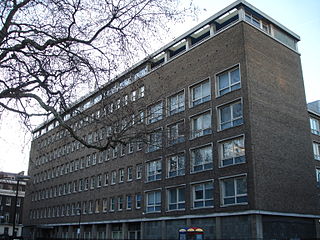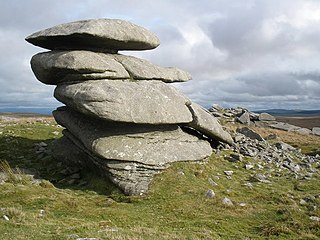Related Research Articles

Bodmin Moor is a granite moorland in north-eastern Cornwall, England, United Kingdom. It is 208 square kilometres (80 sq mi) in size, and dates from the Carboniferous period of geological history. It includes Brown Willy, the highest point in Cornwall, and Rough Tor, a slightly lower peak. Many of Cornwall's rivers have their sources here. It has been inhabited since at least the Neolithic era, when early farmers started clearing trees and farming the land. They left their megalithic monuments, hut circles and cairns, and the Bronze Age culture that followed left further cairns, and more stone circles and stone rows. By medieval and modern times, nearly all the forest was gone and livestock rearing predominated.
Post-processual archaeology, which is sometimes alternatively referred to as the interpretative archaeologies by its adherents, is a movement in archaeological theory that emphasizes the subjectivity of archaeological interpretations. Despite having a vague series of similarities, post-processualism consists of "very diverse strands of thought coalesced into a loose cluster of traditions". Within the post-processualist movement, a wide variety of theoretical viewpoints have been embraced, including structuralism and Neo-Marxism, as have a variety of different archaeological techniques, such as phenomenology.
Ian Richard Hodder is a British archaeologist and pioneer of postprocessualist theory in archaeology that first took root among his students and in his own work between 1980 and 1990. At this time he had such students as Henrietta Moore, Ajay Pratap, Nandini Rao, Mike Parker Pearson, Paul Lane, John Muke, Sheena Crawford, Nick Merriman, Michael Shanks and Christopher Tilley. As of 2002, he is Dunlevie Family Professor of Anthropology at Stanford University in the United States.

UCL's Institute of Archaeology is an academic department of the Social & Historical Sciences Faculty of University College London (UCL) which it joined in 1986 having previously been a school of the University of London. It is currently one of the largest centres for the study of archaeology, cultural heritage and museum studies in the world, with over 100 members of staff and 600 students housed in a 1950s building on the north side of Gordon Square in the Bloomsbury area of Central London.
Archaeological theory refers to the various intellectual frameworks through which archaeologists interpret archaeological data. Archaeological theory functions as the application of philosophy of science to archaeology, and is occasionally referred to as philosophy of archaeology. There is no one singular theory of archaeology, but many, with different archaeologists believing that information should be interpreted in different ways. Throughout the history of the discipline, various trends of support for certain archaeological theories have emerged, peaked, and in some cases died out. Different archaeological theories differ on what the goals of the discipline are and how they can be achieved.
Michael Parker Pearson, is an English archaeologist specialising in the study of the Neolithic British Isles, Madagascar and the archaeology of death and burial. A professor at the UCL Institute of Archaeology, he previously worked for 25 years as a professor at the University of Sheffield in England, and was the director of the Stonehenge Riverside Project. A prolific author, he has also written a variety of books on the subject.

Archaeology or archeology is the study of human activity through the recovery and analysis of material culture. The archaeological record consists of artifacts, architecture, biofacts or ecofacts, sites, and cultural landscapes. Archaeology can be considered both a social science and a branch of the humanities. It is usually considered an independent academic discipline, but may also be classified as part of anthropology, history or geography.
In archaeology, phenomenology is the application of sensory experiences to view and interpret an archaeological site or cultural landscape in the past. It views space as socially produced and is concerned with the ways people experience and understand spaces, places, and landscapes. Phenomenology became a part of the Post-processual archaeology movement in the early 1990s and was a reaction to Processual archaeology's proposed 'scientific' treatment of space as an abstract and empty locus for action. In contrast, phenomenology proposes a 'humanized' space which is embedded with meaning and is created through praxis. Phenomenology therefore treats the landscape as a network of places, each of which bears meaning and is connected through movements and narratives.
The archaeology of religion and ritual is a growing field of study within archaeology that applies ideas from religious studies, theory and methods, anthropological theory, and archaeological and historical methods and theories to the study of religion and ritual in past human societies from a material perspective.

Sue Hamilton is a British archaeologist and Professor of Prehistory at the UCL Institute of Archaeology. A material culture specialist and landscape archaeologist, she was the UCL Institute of Archaeology's first permanent female director (2014–22).

Craddock Moor Stone Circle or Craddock Moor Circle is a stone circle located near Minions on Bodmin Moor in Cornwall, UK. It is situated around half a mile Northwest of The Hurlers.

Brown Gelly is a tor, hill and ridge near Dozmary Pool on Bodmin Moor near Liskeard in Cornwall, UK.

Showery Tor is a rocky outcrop on a ridge-top approximately 0.6 kilometres (0.37 mi) north of the Rough Tor summit, near Camelford on Bodmin Moor in Cornwall. It is notable for its rock formations and prehistoric monuments.
Goodaver, Goodaver stone circle or Goodaver circle is a stone circle located in the parish of Altarnun, near Bolventor on Bodmin Moor in Cornwall.

Brown Willy is a hill in Cornwall, England, United Kingdom. The summit, at 1,378 feet above sea level, is the highest point of Bodmin Moor and of Cornwall as a whole. It is about 2+1⁄2 miles northwest of Bolventor and 4 miles southeast of Camelford. The hill has a variable appearance that depends on the vantage point from which it is seen. It bears the conical appearance of a sugarloaf from the north but widens into a long multi-peaked crest from closer range.
Susanne Küchler, FBA is a German anthropologist and academic, who specialises in material culture. Since 2006, she has been a professor at University College London. She previously worked at the University of East Anglia and the Johns Hopkins University.
Barbara Bender is an anthropologist and archaeologist. She is currently Emeritus Professor of Heritage Anthropology at University College London.
Michael John Rowlands is a retired British academic and anthropologist. He was Professor of Anthropology and Material Culture at University College London from 1993 to 2010.
Leskernick Hill is on Bodmin Moor in Cornwall, UK. It is 329m high and has grid reference SX183803. Leskernick Hill is within the Cornwall AONB as part of Area 12: Bodmin Moor in the parish of Altarnun. It lies in an area of moorland that is common land. Its parent hill is Brown Willy and it is within sight of Rough Tor and other local tors
Mike Seager Thomas is a British archaeologist and Honorary Research Fellow of the UCL Institute of Archaeology specialising in the study of stone in prehistoric archaeology and landscape archaeology.
References
- ↑ "Chris Tilley". UCL Department of Anthropology. Archived from the original on 7 April 2016. Retrieved 27 April 2016.
- ↑ Trigger, Bruce (2006). A History of Archaeological Thought (2nd ed.). Cambridge University Press. pp. 450–452. ISBN 978-0-521-60049-1.
- ↑ Trigger 2006 , pp. 467–468.
- ↑ Shanks, Michael; Tilley, Christopher (1987). Social Theory and Archaeology. Cambridge: Polity Press. p. 195.
- ↑ Tilley 1989. p. 277.
- ↑ Tilley 1989.
- ↑ Trigger 2006 , pp. 472–473.
- ↑ Bender, B, Hamilton, S., and Tilley, C. (1997). Leskernick: Stone worlds, alternative narratives, nested landscapes. Proceedings of the Prehistoric Society 63: 147-178.
- ↑ Hamilton, S., Tilley, C. and Bender, B. (1999). Bronze Age stone worlds of Bodmin Moor: excavating Leskernick. Archaeology International 3: 13–17.
Bibliography
- Tilley, Christopher (1989). "Excavation as theatre". Antiquity. 63 (239): 275–280. doi:10.1017/S0003598X00075992. S2CID 162645732.